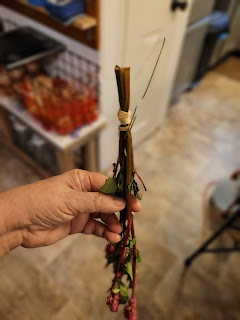When we moved from West Virginia to north Florida, I started meeting plants I'd never heard of.
Like Chaya.
I first met Chaya in David the Good's, Totally Crazy Easy Florida Gardening (pp. 43-44), and learned that the plant is a perennial that can grow in poor soil, and that Chaya leaves are "ridiculously good for you."
After I saw Green Deane's picture of a beautiful Chaya tree in Longwood, Florida, and read, in his Eat the Weeds blog post, "Chaya: The Spinach Tree," about Chaya leaves being "generally twice as nutritious as spinach, Chinese cabbage or amaranth," I began searching for plants to start in my garden.
This September, my friend, Tammy (who's a resilient and creative gardener) generously gave me a branch from her huge Chaya plant!
I made cuttings and,
Now, eleven sturdy baby Chaya plants are tucked in to our unheated greenhouse, where they can wait out the cold weather and be ready for setting out in the Spring.
















